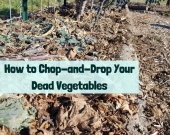
My favorite way to deal with garden pests is to attract predators. But this approach takes time and you have to be willing to give the predators space.
This week’s blog post—
The Number 1 Pest Solution – Attract Predators to Your Garden—dives into how to manage pests through predators.
To be completely transparent I’m still dealing with pests on my wild homestead. But I can see that each year there are less pests in my garden.
So how do you attract predators? Here is a bit about what I’m doing to deal with my most common pests. But don’t forget to
check out the blog post which dives into this topic in more detail.
How I’m Dealing with Pests by Attracting Predators

The biggest pests that I’m dealing with are slugs, voles, and aphids. And slugs by far are the worst.
In a lot of ways aphids are the easiest to deal with since there are so many things that eat them. And really what it takes to deal with them is to have nearby perennial growing areas (hedgerows, food forests, etc.) and lots of flowers.
All of this attracts and supports predators of aphids such as hoverflies, lacewings and ladybugs.
Creating log piles, using mulch and keeping things a little bit messy also provides shelter for these beneficial insects.
But these features also help attract other predators—especially those of slugs.
In my area that includes garter snakes, black ground beetles, frogs and centipedes. These 3 predators are great at helping to keep slugs under control here in western WA.
Rock piles also help and I’ve made sure to add some of those around my growing areas.
But I still need to do a lot more to deal with slugs. I need a lot more log and rock piles but what will make the biggest difference is building some small water features.
These small ponds won’t be for water storage but instead will be year-round water sources for garter snakes, frogs and salamanders. This will help attract them up to my garden which should help a lot with slugs.
But none of this will help that much with voles.
To deal with voles I’m going to install barn owl boxes. There are already owls living around my wild homestead but by installing barn owl boxes I can increase the number that can nest in my area which should reduce the number of voles.
Finally, I’m also planting native plants throughout my wild homestead. These plants support specialist (picky) insects that can only eat those plants. Those picky insects are eaten by songbirds and many other predators.
This increases the amount of prey available for predators without increasing the population of generalist insects that are often pests in the garden.
The result of using all these approaches together along with planting a diverse mix of plants is a healthy ecosystem that supports prey and the predators that eat them. This doesn’t eliminate pests but it does keep them in balance.
Moving Forward

I still got a lot more to do. I need to add more log piles and a lot more rock piles. I need to build the wildlife ponds and I need to plant more native plants.
I’m also planning to plant a lot more flowers and perennial food crops. And I’m still adding snags, and I’m just starting to add bird boxes (including barn owl boxes).
Overtime all of this will attract more and more predators and the result will be less pests.
I really find this approach to be the best way to deal with pests because it’s based on working with nature rather than against it.
And I would love to hear what predators you’re finding in your garden. Spiders? Centipedes? Lacewings? Ladybugs? Snakes? Lizards? Birds?
Please, leave a comment below sharing what predators you find in your garden and what you’re doing to attract them.
And don’t forget to
check out the blog post to learn more about how to attract predators to your garden.
While you are over on the blog most make sure to leave a comment! If you are the first to do so you will get a piece of pie!
The pie will get you access to some special features on perimes, discounts at some vendors, and you can use it to purchase some products on the permies digital marketplace.
If you leave a comment on the
blog post make sure to leave a post here on permies too so I can easily give you the slice of pie.

 14
14










 7
7





 5
5




 6
6




 4
4




 6
6




 2
2




 2
2







 2
2




 2
2








 2
2
















